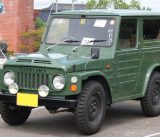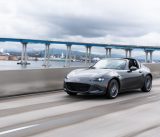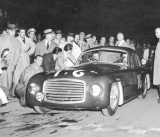The Ford F-150 is officially one of the most most popular and widely sold vehicle on Earth. “A truck?” You say? Yep. With over 40 million units sold since 1948, Ford’s legendary F-Series is about as America as Apple pie – it’s America’s most sold vehicle, after all, second only to the ubiquitous Toyota Corolla worldwide. So, how did a utility vehicle that was realized as little more than a mule with a motor get to its coveted position? Let’s look at the F-Series’ history.

The F-Series quickly received upgrades, including chrome trim and body updates.
A Postwar Utility Vehicle for Returning Joes
For starters, the F-Series, introduced in 1947, was America’s first post-war truck designed by Ford. It provided the Joes returning home from overseas with a familiar vehicle, one that could move cargo and provide reliability with just a few more accouterments and comforts than the Willys they drove in Europe.
The most common F-Series of the first generation, the F-1, set the standard for the average truck, featuring a 6-and-1/2-foot bed, followed closely by the popular F-2 and F-3 trucks with 8-foot beds. The postwar F-Series officially hit the market just after Christmas of 1947 and provided the bare necessities (which was still far more than they enjoyed in the service): A flat windshield, integrated headlamps, an enclosed cab and widened cab, manually operated windshield wipers, and a single taillight. Men of taste could option additional chrome accents and two horns.

The F-Series’ flathead motors provided ample power and reliability, alongside its available all-wheel-drive.
Optioned with War-Time Performance
Notably, all F-Series came optioned with “Marmon-Harrington All Wheel Drive”. It’s argued this drivetrain gained the favor of most car-buying American men of the day – Marmon-Herrington developed the axles and transfer cases for wartime equipment and it’s this technology that allowed the military to remain agile and men to stay alive. The drivetrain was so popular it remained until 1959.

The F-1 featured a simple but relatively well-equipped interior; it even came with air conditioning.
The powertrain of the F-Series didn’t disappoint, either. Joes who appreciated the surprising capabilities of the Willys’ Hurricane engines would enjoy the flathead 6 and V8 motors available for the F-1 through F6 trucks, providing 95 and 100 horses, respectively. Buyers could choose how to transfer that power through available 3-speed light duty, heavy duty, or 4-speed manual transmissions. Commercial F-Series trucks (the F-7 and F-8) came optioned with either flathead or Y-block V8s and 5-speed manual transmissions with overdrive and direct drive.
From Simple Utility to Comfort and Style
But why did the F-Series rocket ahead as the most popular truck of the time, to remain the most popular pickup, ever? Where other manufacturers like Dodge and Chevy stuck to their guns with slow-to-evolve models, the F-Series rapidly improved after its initial debut: In 1949, just one year past first production, the F-Series received aesthetic changes to its paint and wheel schemes, evolving the truck from a simple tool to a machine of style.

Pictured is a ’51 F-1, featuring a larger rear window and spacious bed.
The F-Series Quickly Evolved Past its Competitors
In 1950, the floor-based shift was relocated to the steering column, setting the standard for how every modern pickup’s drivetrain is controlled by hand. One year later, aesthetics continued to evolve with new chrome accents, polished bezels, emblems, and grille upgrades. Over the course of just a few more production cycles the F-Series received door panels, larger windows, and a hardwood floor. Ford transformed the pickup from a postwar “surplus” vehicle to a true passenger mover.





